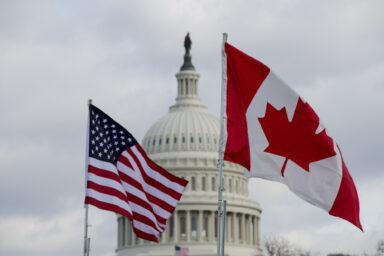An American businessman who manufactures face masks in China says the White House rhetoric makes it more difficult for the US to obtain life-saving products.
As the United States and other countries face shortages of critical medical supplies, manufacturers of items such as face masks and hospital gowns are finding themselves overwhelmed with orders.
As a result, those factory owners often have to choose between clients — a decision that may make the difference between life and death.
In this episode of WhoWhatWhy’s Viral News podcast we talk to Adam Berkenpas. Since moving to China almost 10 years ago, Berkenpas has become a co-owner of two garment factories in southern China and partnered with dozens of other factories throughout the region.
He provides a glimpse behind the curtain of how manufacturers in China operate — and how thousands, if not millions, of lives are potentially affected by their decisions.
Click HERE to Download Mp3
Full Text Transcript:
As a service to our readers, we provide transcripts with our podcasts. We try to ensure that these transcripts do not include errors. However, due to time constraints, we are not always able to proofread them as closely as we would like. Should you spot any errors, we’d be grateful if you would notify us.
Hello and welcome to Viral News. I’m your host Stephen Calabria. Viral News is a podcast produced and released by WhoWhatWhy.org, dedicated to the coronavirus, and other news of a viral sort.
On today’s program, we’ll feature two separate conversations with Adam Berkenpas, the co-owner of two factories in China that manufacture, among other things, medical face masks. The first of the conversations took place in late March, just after we’d all launched into our collective crisis, and the second took place just this week.
Right now is a, let’s say, unique time to own face mask factories in China. What we refer to as the novel coronavirus is believed to have originated in the Chinese city of Wuhan in late December, with its first recorded death on January 11th.
The origins of the virus have led to a reported spike in anti-Asian sentiment across the United States and much of the world. This is on top of the already fraught trade relationship between the United States and China in general, because why not drop 50 gallons of gasoline on a raging forest fire?
That fraught trade relationship faces further tensions in the wake of the coronavirus, as many of the most crucial medical products in the fight against the virus are manufactured in China.
Which brings us to Adam Berkenpas, a Michigan native who has lived in China for roughly a decade. He co-owns two factories in the south of China and works with dozens of others in the production of apparel, medical face masks in particular. Here was our talk, on March 26.
How did things on the ground change in Southern China, both for the business and for yourself?
A lot of factories have bought machines to make 3PLY masks. You’ll see a lot of factories have just gotten FDA approval because they’ve just switched over to creating medical supplies. Some of them are licensed, some of them are not licensed.
Rigorous US process in order to become licensed?
I believe so. The licensing that seems to be easier would be from the Chinese government to allow these factories to start making these goods, but for import into the US, they’re going to need these documents, the FDA approval.
How does mask making work? How easy is it to get the machinery, start up production?
That’s something that my Chinese partner is handling, because I’ve been locked out of China since the beginning of this, so he was able to obtain the machines and obtain the clearance from the Chinese government. So, I’ve been stuck in Japan. It’s hard for me to get back to China because there’s a mandatory 14-day quarantine. They’re not allowing travel from certain countries that are high-risk, which would include Japan.
Company and factory have switched over to making masks. What is the situation on the ground like in China in terms of the orders you’re having to process.
It’s pretty difficult right now because I’m having to turn down most organizations that come to me and ask for masks, or I’m having to recommend other companies or source other companies for them to make those masks, because we only have a very limited capacity. We’re not a large organization.
How many masks are you able to produce?
Per day, about a million. Of the 3PLY — it could be for surgical use or non-surgical use. They’re relatively easy to make. Almost any factory could buy the machines and start making them within a few days. And I’ve actually received requests from the US, from US clients, that said, “Could you help us get machines here, to make them here?”
And what do you tell those customers?
That’s not something I’ve done before. I’ve never exported machinery, so I don’t feel comfortable doing that, but I can point them in the right direction.
So when someone asks you for this, in what direction do you typically send them?
I’ll just give them the number of someone I think they can obtain a machine from.
And those are also in China or in America?
Those are in China.
Who would you say are your biggest customers, would you say?
Right now it’s local fire departments, local hospitals in my home state of Michigan. Small organizations like that.
Was that by design? How did that fall into place?
No, it’s actually just because friends of mine gave my contact information to departments of hospitals and they contacted me and asked me if I could help. I haven’t been attempting to gain new customers. I don’t really have the time for it. I’m bombarded with orders. It’s very stressful, because I have to pick and choose who to help. I have a lot of friends in the Philippines, as well, and they’re having trouble getting them through customs.
How so?
Well, the last time I checked, they’re stuck in customs. They can’t get them through, and they’re asking for donations. I’ve been contacted by an agency in Guatemala, as well, but I haven’t exported to these countries before, so it’s hard for me to export to them, so I’m looking for government contacts that can do that for me.
Contacts within those governments that would be able to help you export masks into them. What are those–
Yes, because it’s been private agencies — for example, in the Philippines — that don’t have those connections.
Who are the countries that you’ve been dealing with that would most benefit from streamlining the processes for getting masks into those countries?
It seems to me that Philippines — I’ve gotten a lot of requests from local hospitals that are in short supply. And I’ve received one request from Guatemala, I’m not sure about their current situation.
Are masks the only product that you are producing currently?
Well, there’s two different kinds of masks: There’s 3PLY masks and there’s N95 respirators. So, a typical facemask or surgical mask, is resistant to blood splashes, bodily fluid splashes. But there’s air coming from both sides, so it’s not resistant to airborne particles. Only N95 respirators are resistant to airborne particles. So I think that’s an important distinction that the average person needs to know.
And who is the typical person that would use a regular face mask versus one of the respirators?
Doctors use both. During this time, nurses and doctors are all using respirators, police officers, fire departments are using respirators.
And are respirators that much more difficult to produce than the regular face masks?
They are in a bit shorter supply. The NIOSH-certified ones are in much shorter supply. The Chinese-certified KN95s are more readily available and can be produced faster.
But is there a difference though between the ability to produce regular face masks and the ability to produce respirators? Is one more difficult than the other?
Yes, there’s only a few factories that are producing the respirators. It’s easier for factories to produce facemasks.
Okay, and what are the impediments to producing more respirators? Are there greater numbers of certifications that you need, different kinds of equipment? How does it work?
Yes, it’s the certifications, the equipment. Most of these respirators, they’re brands, so they’re not generic. They have to be from a brand that is certified by the FDA, that is on the CDC website. You can look this up on the CDC website. When you see a respirator online or someone tries to sell you a respirator, take a look at the model number and the brand, look at the CDC website, and make sure that it’s FDA-approved, NIOSH-approved. ]
Why is it not something that’s possible to produce in the United States?
That’s a good question that I wouldn’t be able to answer, because I’ve been doing manufacturing in China for the last 8 years. As far as I know, it’s a labor issue. That’s why I have not manufactured in the US, is a labor issue, the cost of labor and the price that my products need to be at the sell at wholesale, in order to compete with other garment companies. So, that has been my issue doing garments for 8 years.
Why is there such limited capacity, both in your factory and those elsewhere, in producing these masks?
It’s just the demand. The demand is there. They’re working around the clock. They’re stuffed with workers. There’s just such a high demand. Not just from America but from other countries. I’ve received requests from Israel, from Belgium, the UK, possibly — I don’t remember the other countries, but it’s not just America right now. There’s a lot of countries that are trying to get these masks urgently.
You had a stockpile up until recently, correct?
Yeah, for only a few days. Yeah, it was about a million masks. This was before things got really bad in the US, so I don’t think the demand was there yet, and we had had them because of the crisis in China.
You had produced them for Chinese customers who were looking for —
Yes.
And then, as demand in China went down, demand from the United States and elsewhere went up?
Correct, yeah. It seemed to happen overnight.
And you, perhaps, were in no position to accommodate such a skyrocketing level of demand over such a short period of time.
No, no.
In this case, what kinds of lead times are customers looking at right now?
It depends on the country. For 3PLY masks, it’s taking, currently, a couple days to produce 1 to 2 million pieces, and then about three to five days shipping. I’m usually using the DHL or UPS or FedEx, which takes around three to five days, and a day or two to clear customs in the US.
Ok, so you’re looking at around a week.
Best-case scenario, yeah. But I’m getting a lot of requests for NIOSH-certified masks, which is a different certification than the simple 3PLY and my partners make those, I don’t make those directly, but those are in much shorter supply, and there seems to be a much higher demand for those, because those are what the professionals are using in the hospitals, in the fire departments.
And what are the regular masks called?
Well, there’s a few different kinds. There’s 3PLY, a sort of common mask that is not for surgical use. Then there’s a 3PLY mask, which is basically like a three-layer mask for surgical use, and then there’s the five-layer masks, which would be known as a KN95 or an N95. KN95 is a Chinese-certified mask. Basically, the equivalent of an N95. Those are more readily available than the American version, which would be the NIOSH-certified version.
However, the KN95, some manufacturers — not all, some — have FDA approval on those, which I would urge anyone purchasing those to check.
Why?
Check the FDA approval, on any mask that you’re ordering from a Chinese supplier.
Why is that?
Because you need that. You need that in your hospital, otherwise your hospital is liable.
I see. And what is the difference?
The difference is that it’s certified by the FDA. For example, amphetamines. Amphetamines aren’t certified by the FDA. We can’t go around taking amphetamines.
Right. And so what is the difference between a mask that a surgeon would use and a mask that everyone else would use?
It’s just the fluid retention. It’s just a better quality.
Would you say that the rhetoric coming out of the White House and certain other quarters is helping or hurting the likelihood that these kinds of supplies will be distributed stateside in a timely manner, at least when it comes to rhetoric surrounding China and the virus?
It seems without a doubt, I have to be honest here, it seems that it’s hurting it.
The ability to deliver masks and other medical supplies to the United States is being hurt by the rhetoric.
Yeah. Basically, we don’t want to be sending out this blame game to China, because they’re the ones saving our lives right now. They’re the ones making these on the ground level. The workers. The factory owners. Obviously everything from the US media is going to be filtered through the Chinese media, so take from that — I don’t want to give out too much information, because I don’t want to anger the Chinese government and anger my partners, as well. But, in general, it seems to me that the information coming from US media is not making the Chinese happy, because it seems to be that they’re being blamed.
So what could the United States be doing to make these processes easier, from your point of view?
I would say, encourage organizations to work with Chinese organizations, and not be scared to do it, because they can’t look at them as an enemy. They’re our friends in this situation. We need them.
Was there anything else that you wanted to say?
Yeah, I think that’s the main reason I came here, is that I just want to encourage people to have a more open-minded approach to getting their medical supplies from China, and for the average person, for the common person in quarantine right now, China is saving our lives right now, so try not to be racist.
If any of our listeners would like to purchase a bulk order of these kinds of masks and distribute them in their communities, how would they best get in touch with you?
You can get in touch with me at Adam@authenticmanufacturing.com and my website is authenticmanufacturing.com. My company name is Unique Customs, LLC.
Okay, well, Adam Berkenpas, thank you so much for coming on the show.
Thanks, Stephen.
We’ll be right back with our follow-up interview with Adam, but first, be sure to check out WhoWhatWhy’s other podcast, Radio WhoWhatWhy, hosted by radio personality and journalist Jeff Schechtman. Also, to read WhoWhatWhy’s groundbreaking print reporting, check out the site on the web at whowhatwhy.org, and on Twitter.
Since our first conversation with Adam, the fight against the novel coronavirus has evolved significantly. As of this recording on April 15, the United States is number 1 in the world in both recorded cases and recorded deaths, with over 641,000 cases and over 28,000 deaths.
Data from the U.S. Centers for Disease Control and Prevention finds that far more Americans have complied with social distancing measures than had been predicted, Forecasting models now anticipate the number of American deaths to be fewer than 70,000, a drastic difference from the predictions of some models in March that put the American death toll at around 2 million.
Things have been no less complicated on the Chinese side of the divide. On the plus side, new cases are also down around the country and cities are slowly but surely ending their lockdowns.
And yet, much like the United States,China’s economy has taken a huge hit. The situation is exacerbated by trade tensions, and the ongoing shortage of needed medical supplies like facemasks and hospital gowns.
According to the Department of Health and Human Services, the United States would need approximately 3.5 billion masks in the event of a yearlong pandemic; as of mid-March, the Strategic National Stockpile had around 12 million, which is a bit like saying, I want to download all 8 seasons of Game of Thrones using only my dial-up connection.
On April 14, we called Adam to check in on how things were going at what is one of the world’s epicenters of manufacturing.
[Missing second interview transcript]
If you liked this podcast, please share it and help others find it by rating and reviewing it on iTunes, Spotify, and wherever you get your podcasts. The show is a production of WhoWhatWhy.org, which depends on contributions from readers and listeners like you. To make a donation, visit the website at whowhatwhy.org.
Once again, I’m Stephen Calabria. Stay safe, and stay home.
Related front page panorama photo credit: Adapted by WhoWhatWhy from Jo. / Flickr (CC BY 2.0) and Shibuya246 / Flickr (CC BY-NC 2.0).



